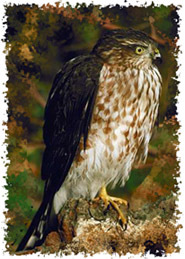

The sharp-shinned hawk (Accipiter striatus) is a small accipiter about 10 inches long with a 21-inch wingspan. It is similar to the Cooper's hawk, but smaller with a squared tail. The Cooper's hawk is crow sized and has a rounded tail.
Coloration of the adult male is bluish gray upperparts, underparts white, barred heavily with reddish brown; legs and feet slender and yellow. The adult female is similar to male but upperparts are browner, less bluish. Immatures are dark brown above; white below, streaked with pale reddish brown.
Found all over most of North America, this small hawk prefers open woodlands and wood edges. Coniferous forests are preferred over deciduous forests for nest sites across the hawk's North American range. Sharpies breed from Alaska across Canada to Newfoundland, north to the tree limit, and south over much of the United States. Additional races occur in the West Indies and South America.
The sharp-shinned hawk nests from April to July. The nest is made of small sticks lined with finer ones. Usually placed at low (12 to 30 feet) heights in conifers, spruce being chosen most often. The selected nest tree is usually growing on the edge of a path or roadway in the woods or on the edge of a clearing. There are 3-6 (sets of 4 being common) eggs laid. They are bluish white to buff, distinctly blotched or sometimes washed with rich chocolate-brown or cinnamon-rufous. Both parents tend the nest. The incubation period is about 35 days. If a first nest is destroyed, this hawk will usually try once more.
Sharp-shinned hawks are fierce, bold hunters that prey primarily on small birds. They hunt either by cruising through wooded areas or dense brush and flushing small birds and then overtaking them in flight; or by sitting on a perch and watching for unsuspecting prey.
On occasion I've seen a sharpie dive into my yard chasing the little sparrows into the shrubs that are near the feeders. The little hawk will actually go into the shrubs right after the little birds, but generally comes out empty beaked. That is why I always place my feeders near and even in the small trees and shrubs in my yard to even the stakes for the little sparrows and warblers. I think they appreciate it.





